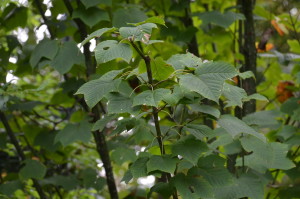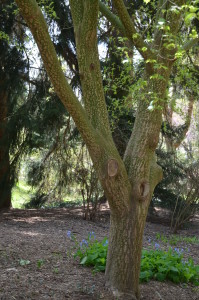In the world of maples the snakebark trait is unique. Redvein maple (Acer rufinerve) from Japan belongs in this maple category (USDA hardiness zones 5-7). It is a small to medium deciduous tree or large shrub with an upright branching framework. A young tree starts off slowly and may grow only to 12-15 feet in 10 to 12 years. The species matures to 30 feet tall and 20 feet wide.
As spring season approaches, dormant buds turn red, swell, and 3- to 5-lobed green leaves emerge. Autumn foliage may turn yellow, burnt orange, or purple depending on the year and locality. Autumn leaf colors are best where soil moisture has been plentiful and the tree is grown under partial shade.
Raceme flowers run about 3 inches long bearing the winged samara seeds that ripen in fall. The species name rufinerve refers to the rusty red hairs along the leaf vein axils which slough off by mid-summer. The main trunk is green with gray-white striations
The cultivar ‘Winter Gold’ displays a bright yellow bark with tiny dark specks along the main trunk and main branches. Summer and fall bark is greenish yellow and is brightly yellow in winter. Like the species, Winter Gold prefers partial shade and moderate soil moisture. Enjoy as a specimen against an evergreen shrub background or plant nearby a patio for year-round viewing.
As previously stated, redvein maple grows best in a well-drained, moist, compost-rich, moderately acidic soil, and in partial sunlight. It struggles in full sun and in dry soils. Newly-planted and young trees should be kept mulched and adequately watered during extreme summer dry spells. Established trees are moderately drought tolerant and have few disease and pest issues. Pruning is rarely necessary except to develop a good central leader on a young tree.
Redvein maple and the Winter Gold cultivar are available from on-line mail order nurseries.



 Posted in
Posted in 
